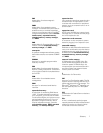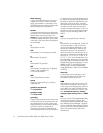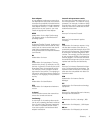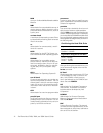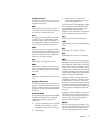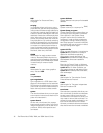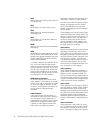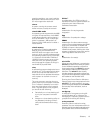
14 Dell PowerVault 720N, 740N, and 760N Users Guide
sequentially across the available disks and
no redundancy is provided. RAID 0 config-
urations provide very high performance
but relatively low reliability. RAID 0 is the
best choice when DSA controller cards
are duplexed. See also striping.
5$,'
RAID 1 is commonly called
mirroring
.
RAID 1 also uses striping, so RAID 1 may
be regarded as the mirroring of RAID 0
configurations. RAID 1 is the best choice
in high-availability applications that require
high performance or relatively low data ca-
pacity. See also mirroring, RAID 10,
striping.
5$,'
RAID 4 is commonly called
guarding
. It
uses data striping, like RAID 0, but adds a
single, dedicated parity drive. The parity
data stored on this drive can be used to
recover data lost from a single failed drive.
RAID 4 configurations write data slowly
because parity data has to be generated
and written to the parity drive, and the
generation of the parity data frequently re-
quires reading data from multiple physical
drives. See also guarding and striping.
5$,'
RAID 5, like RAID 4, is commonly called
guarding
. RAID 5 is identical to RAID 4,
except that the parity data is distributed
evenly across all physical drives instead
of a parity drive. In configurations using a
large number of physical drives in which
a large number of simultaneous small
write operations are being performed,
RAID 5 offers potentially higher perfor-
mance than RAID 4. RAID 4 and RAID 5
configurations are appropriate in high-
availability applications where perfor-
mance is less critical or where high data
capacity is required. See also guarding.
5$,'
RAID 10 is a mirroring technique in which
data is duplicated across two identical
RAID 0 arrays or hard-disk drives. All data
on a physical drive in one array is duplicat-
ed, or
mirrored
, on a drive in the second
array. Mirroring offers complete redun-
dancy of data for greater data security.
See also mirroring, RAID 1, and striping.
5$0
Acronym for random-access memory.
The computers primary temporary stor-
age area for program instructions and
data. Each location in RAM is identified by
a number called a
memory address
. Any
information stored in RAM is lost when you
turn off your computer.
5$0'$&
Acronym for random-access memory
digital-to-analog converter.
UHDGRQO\ILOH
A read-only file is one that you are prohib-
ited from editing or deleting. A file can
have read-only status if:
Its read-only attribute is enabled.
It resides on a physically write-
protected diskette.
It is located on a network in a
directory to which the system
administrator has assigned read-
only rights to you.
UHDOPRGH
An operating mode supported by 80286
or higher microprocessors, real mode
imitates the architecture of an 8086
microprocessor. Designed to run in real
mode, MS-DOS (unassisted by additional
software techniques) can address only
640 KB of conventional memory.
UHIUHVKUDWH
The frequency, measured in Hz, at which
the screens horizontal lines are re-
charged. A monitors refresh rate is also
referred to as its
vertical frequency
.
5(1
Abbreviation for ringer equivalence
number.
5),
Abbreviation for radio frequency
interference.
5*%
Abbreviation for red/green/blue.




